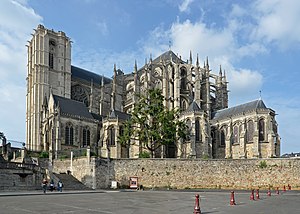Le Mans Cathedral
| Cathedral of Saint Julian of Le Mans Cathédrale Saint-Julien du Mans |
|
|---|---|

Le Mans Cathedral seen from the southeast (Place des Huguenots)
|
|
| Basic information | |
| Location | Le Mans, France |
| Geographic coordinates | 48°0′33″N 0°11′56″E / 48.00917°N 0.19889°ECoordinates: 48°0′33″N 0°11′56″E / 48.00917°N 0.19889°E |
| Affiliation | Roman Catholic Church |
| Province | Diocese of Le Mans |
| Region | Pays de la Loire |
| Ecclesiastical or organizational status | Cathedral |
| Status | Active |
| Architectural description | |
| Architectural type | Church |
| Architectural style | Roman; French Gothic |
| Groundbreaking | 6th century |
| Completed | 14th century |
Le Mans Cathedral (Cathédrale St-Julien du Mans) is a Catholic cathedral situated in Le Mans, France. It is dedicated to Saint Julian of Le Mans, the city's first bishop, who established Christianity in the area around the beginning of the 4th century. Its construction dated from the 6th through the 14th century, and it features many French Gothic elements.
The cathedral, which combines a Romanesque nave and a High Gothic choir, is notable for its rich collection of stained glass and the spectacular bifurcating flying buttresses at its eastern end.
Nothing is known about the form of the original church founded here by St Julian, which was co-dedicated (as with many early cathedrals) to The Virgin and to St Peter. Although there is no archaeological evidence for the building phases prior to 1080, the history of the bishopric and its cathedral is extensively detailed in the 9th century Actus pontificum Cenomannis in urbe degentium According to this chronicle, in the first half of the 9th century, a major rebuilding of Julian's original cathedral took place under Bishop Aldric.
This new building, designed to house the relics of St Julian, incorporated a large choir (consecrated 834) with an apse and an ambulatory housing five altars – possibly one of the very earliest examples of the chevet-type design that later became a standard for major churches throughout northern Europe. Another remodelling was undertaken throughout the second half of the 11th century (begun under Bishop Vulgrin c.1060, completed under Bishop Hildevert and consecrated 1120).
The cathedral occupies the northeastern corner of the old town (known as Vieux Mans or the Cité Plantagenêt), an area on top of a slight ridge dominated by cobbled streets and half-timbered houses.
The current nave is of a typical Romanesque basilica form, with round-arched arcades and single aisles either side of a larger central vessel lit by clerestory windows. Following a fire in 1134, a major rebuilding programme was begun by Bishop Guillaume de Passavant (reg.1142–1186). The new works were partly funded by King Henry II of England, whose father, Geoffroy of Anjou, was buried here in 1151. Whereas the previous buildings had all featured a wooden roof, Bishop Guillaume's new nave, which today survives largely intact, incorporated stone vaults. This feature required considerable thickening of the old walls and the addition of flying buttresses along the flanks of the nave.
...
Wikipedia
